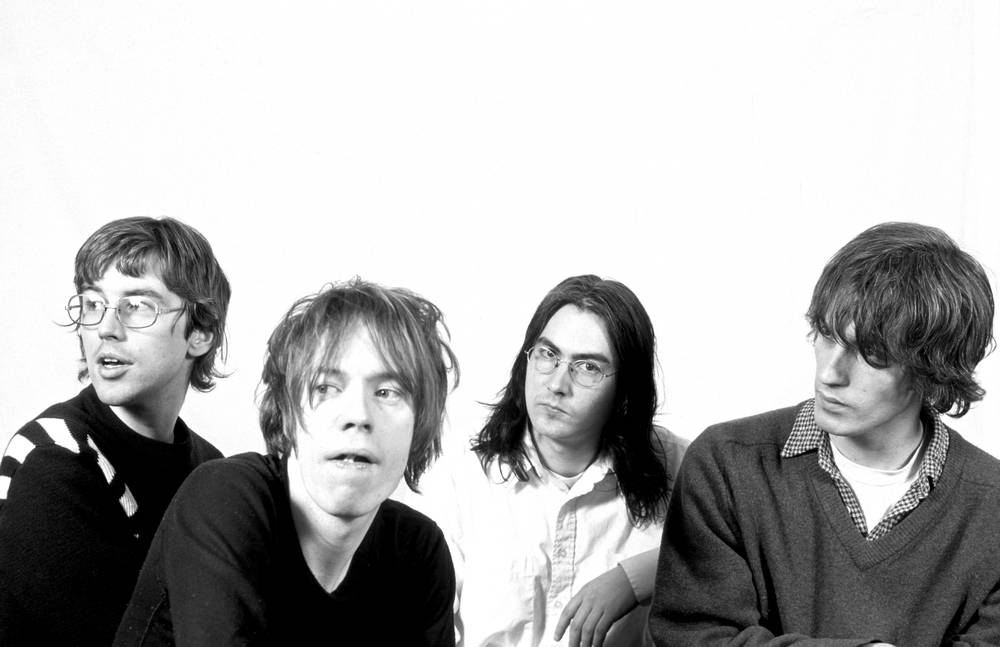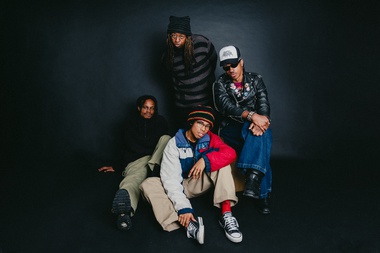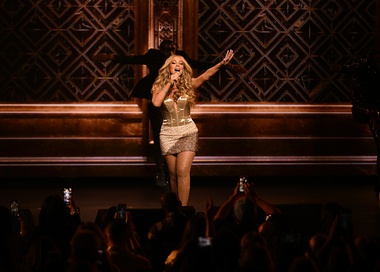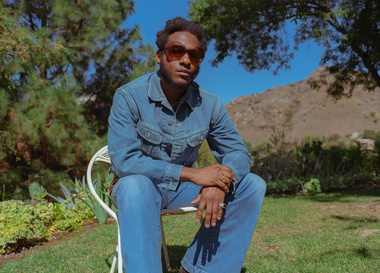Canadian power-pop outfit Sloan is celebrating the 20th anniversary of its top-selling album, 1996’s One Chord to Another by issuing a new boxed-set version and playing the original record in full on tour. We chatted with guitarist/vocalist/songwriter Jay Ferguson about Sloan’s first-ever show in Las Vegas (and his first-ever visit to the city), One Chord’s pivotal role and the impending release of new music.
When you ranked Sloan’s records for Noisey last year, you placed One Chord to Another No. 1. Why does it stand out for you? I really like the songs. I mean, I like all of our records—I’m not embarrassed by any of them—but I really like the songs on that record. It’s [also] a little bit special, because it’s the first Sloan album that we put out on our own record label, Murderecords here in Canada. Our previous two records were on Geffen out of the United States.
Our second album on Geffen was called Twice Removed—it was a record that we made in New York, and they knew it was being made, and our A&R guy was on top of it. But when we handed it in, the marketing department was like, “We don’t know how to market this record. This doesn’t sound like the first Sloan album.” So they wanted us to redo it. We said no, put it out as-is. They said, “Okay, we’ll put it out, but we can’t guarantee anything’s going to happen, marketing- or promotion-wise.” And that was the case. It died instantly.
It was a very frustrating time for our band, because of that reception. It did okay in Canada. So our band took time off. We didn’t know if we were going to break up or get back together. When we decided to get back together, to make One Chord to Another, we actually offered it to Geffen, but we decided not to go that route again. We released it on Murderecords and recorded the drums, like, on a four-track cassette, in order to save money.
It ended up becoming our most successful album to date, [and] it really kick-started the modern-day Sloan, for me anyhow, in that we kind of grabbed all the reins of marketing decisions and promotion. It’s like running your own small business. So that made it really rewarding.
There are so many bands, especially in the ’90s, that never got that chance, especially if they were on a major label. They had two records, and if the second one didn’t do well, they were done. Oh, for sure. I can think of two other bands who were even on Geffen during the ’90s, and they handed in a record and [the label was] like, “No, we don’t think so. Go make it again.” [The first band] went and made it again—then that [album] was released and it flopped, or they didn’t do anything about it. So here’s this poor band, made their record twice, probably wasted a year or two of their life doing that, and still nothing happened. Another band who are friends of ours had to make their second album three times, and the third time it was rejected anyhow, and then nothing happened. So they took two-and-a-half or three years to make three albums of the same album, and Geffen continued saying, “No, we don’t think so—try it again.” I would go crazy being in that situation.
Sloan has been successful in Canada, and successful on an underground level in the United States. We’ve never been million sellers or anything like that, but I’m grateful that we’ve been able to at least steer our own career a little bit more than a lot of other peers, definitely from the ’90s.
Doing One Chord to Another on your own terms, and having it be it so successful, must have been vindication. It was. It was great, too, because I didn’t want Sloan to end, especially after Twice Removed. When we all decided, “Let’s try it again and we’ll put it out on Murderecords,” you know, with low expectations—and then it really caught on—like you said, it was rewarding. It was a really fun time for sure.
One Chord to Another came out on an indie label here in the U.S., a year after it came out in Canada. I remember it being hard to find at the time. So it’s like you get a second chance to reintroduce some people to this one 20 years later. Right! (laughs) That’s why we’re doing these box sets [of each Sloan album], basically trying to reintroduce everybody in America to our complete catalog. We’re working our way through our catalog.
We signed to that [U.S. indie label], Enclave, in late ’96, and they put it out in ’97. It started off well. It was run by a guy named Tom Zutaut, who used to be one of the head A&R guys at Geffen, ironically. He signed Guns N’ Roses. When he started the Enclave, I think he wanted Sloan on his label to make a success out of our band, in order be able to point the finger at Geffen, like, “Look what I was able to do, that you guys couldn’t!” or something like that.
But anyhow, like nine months later, Enclave went belly up due to a total musical chairs shift within EMI, [a] restructuring kind of thing, because his label was part of the EMI umbrella at the time. So you’re right, One Chord has always been a little bit more difficult to find in the United States.
I remember talking to some friends around that time, about us trying to find the record. It was like a mythical lost album, and it was obviously harder to hear albums in the pre-digital era. I remember hearing, back in the mid-’90s, [that] before One Chord to Another was out in the States, there would be Sloan fans in Cleveland or even Detroit who would drive across the border in order to buy One Chord to Another. The idea of that happening now is so ludicrous, because all you have to do is turn on your computer and Google it.
As you’ve been playing the album live in order, have you gleaned any new insights about it? A little bit. There are a number of songs that we do still keep in our regular setlist—“The Good in Everyone,” “Everything You’ve Done Wrong” and “The Lines You Amend.” “G Turns to D” shows up from time to time. So there’s still a number of songs that we’re quite familiar with playing. But the interesting thing is playing them in the context of the record, instead of where they would normally go in our set.
The other thing that I’ve learned is that I really don’t like singing “Junior Panthers,” which is the fourth song on the record. [With] the key that it’s in and the singing range, it’s so hard to push your voice. Like, it’s in such a low range for me that I dread when I see it coming up on the setlist. So what I’ve learned from doing One Chord to Another is that I don’t really want to do “Junior Panthers” ever again after the One Chord tour is over! But the rest of the record, yeah, I enjoy playing it.
It’s impressive that you guys aren’t futzing with the key signature, moving it up a couple of steps. You’ll suffer for the art. Oh yeah, I like keeping it pure and keeping it as it was, for sure. I saw some clip of Elton John recently, and he was doing “Goodbye Yellow Brick Road” down a couple of steps, and I was like, “Oh man, it’s a drag. It doesn’t sound the way it did.” And I haven’t seen Fleetwood Mac on any of their recent tours, but some friends of mine went, and when they’re doing “Rhiannon,” Stevie Nicks never goes up high anymore. She just sings those melodies low, and they said, “Oh, it’s about three steps down.” I understand people’s voices change, but it’s hard. So anyhow, we’re suffering for our art and suffering for the fans, to keep it pure, yeah!
Is it my imagination that Sloan has been touring a little bit more in the U.S. in recent years? I know you’re playing some cities you haven’t hit before. Have you guys made a concerted push to come down here more? I don’t think we’re pushing to be like, “This is the year we’re going to make it in the States!” But yeah, we had an opportunity to play a number of California shows, so we took advantage of that. We’re playing a lot of shows that we haven’t done out there, such as Las Vegas and maybe Santa Ana—places that we haven’t been, or maybe we went to once 20 years ago. So that’s a little bit different.
We’ll still go back to the regular ones, like Cleveland, Boston, New York City, D.C. and things like that. But occasionally we get offers for other cities. Not to sound like an old man talking about the Internet, but I do feel like, [with] the way the Internet has flattened the world, we do find that there’s more fans coming out of the woodwork than before, because it’s easier to access music.
We have a lot of direct-to-fan dealings, just through the way we sell box sets and things like that. So we feel that we’re still getting new fans and we’re also still stoking the fire of the already hardcore Sloan fans, by selling box sets off of our websites and limited-edition singles and things like that. It’s been a really good way of staying in touch with hardcore fans. That’s really enabled us to keep a little bit of fire going in a lot of different American cities, [and] still adding new ones here and there when promoters are really encouraging for us to come to places that we’ve never been to before.
Where are people discovering you guys now? Do you have any sense about how people are coming to the band? I don’t have any statistics. We have a guy who helps us with our online, direct-to-fan stuff, and then Patrick [Pentland] in our band really handles the Twitter accounts, and he started [our] Snapchat, which I have not seen yet. We’re all involved in the Instagram account. I’ll put stuff on the Facebook page. I don’t know, exactly. I think it’s just a combination of all of those things.
I don’t know if I’d like to be a brand new band right now, trying to cut through all of the noise of everybody that’s trying to get attention. But all of those tools are great for a band like us that’s had a long career and already has a fanbase. I don’t know if there’s a record company that would be willing to really invest money in a 25-year-old band in order to really reach those fans on a yearly basis. So the fact that we can connect to our fans on a one-to-one level, I think really keeps our band alive.
Sloan turns 25 this year. To what do you attribute your longevity? Moderate success! That’s what will keep your band together. Not bottoming out, and not being so successful and rich that you become obnoxious and you don’t need to work or something.
Splitting the money four ways will help keep your band together, because you’re all in the same boat. Everybody in our band sings and writes and contributes, but if someone has a good year where they have a hit song on the radio, then everybody benefits. The next year, someone else is going to write a song that’s going to do well at radio, but everybody still benefits. And everybody puts in work in different areas. That will help keep your band together.
[Otherwise] one person, a la Sting in The Police or something, is going to be so much more wealthy than the others, because he wrote all of the hit songs and probably didn’t cut the others in for a bit of a slice. That’s going to breed dissension after a while in your band.
And also artistically, it’s an outlet for everybody. It’s not like there’s the disgruntled drummer who’s writing songs but can’t put them on a Sloan album because there’s someone else singing all of the songs. Sloan is an outlet for everybody in the band, and everybody sings and contributes as much or as little as they want. That’s a key factor as well.
That’s kind of like the R.E.M. model. When they started off, they said, “We’re going to split everything four ways. That kept them together. I think U2 might do the same thing. It’s true, U2 for sure. I was a big R.E.M. fan growing up in the ’80s—their early career was really big for me—and I remember reading that and thinking that was a good model.
Are you guys working on any new music? We’re just sort of debating right now. Maybe we’ll do a reissue, another box set a la One Chord to Another for Navy Blues, which is our fourth album. Or do we go back and do [debut LP] Smeared? That might be a bit different, because it really sticks out as a different record in our early catalog. Or are we going to work on some new music? I’m not sure.
I think the next thing that’s actually going to come out [that] we were just recording this past week is two original Christmas songs, which we’ve never done before. We have recorded Christmas covers—Patrick sang “Merry Xmas Everybody,” the Slade ’70s Christmas song, but I don’t know if it really came out. I think we just sort of put it up online. We did “The 12 Days of Christmas” a few years ago as part of a split single with another Canadian band. But this will be the first time we’ve actually written two original holiday songs.
I wrote one called “December 25” and Chris wrote one called “Kids Come Back at Christmas.” Hopefully those will come out as a seven-inch single right before Christmas time. That’s kind of the next thing we’re working on.
Do you have any expectations of Las Vegas? I can’t visualize Las Vegas except for the cliché of the strip and casinos and hotels and, like, no trees. Maybe that’s just the way someone in the United States would imagine Nova Scotia as nothing but a fishing village and a bunch of lobster traps.
I can’t visualize, like, what kind of venues a band like us would play there. But once again, perhaps I’m just imagining the cliché. I’m looking forward to going.
Sloan September 24, 10 p.m., $10. The Sayers Club, 702-761-7618..






